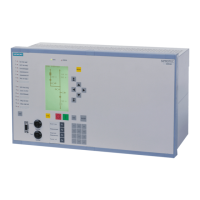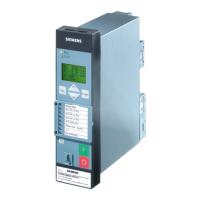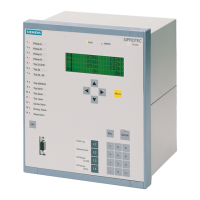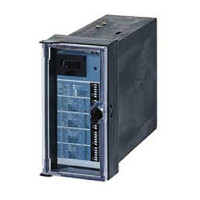Fault direction is calculated with the zero sequence values from the ground current 3Ι0 and displacement
voltage V
0
or 3 · V
0
. With these quantities ground active power and ground reactive power is calculated.
The calculation algorithm used filters the measured values so that it is highly accurate and insensitive to
higher harmonics (particularly the 3rd and 5th harmonics – which are often present in zero sequence
currents). Direction determination relies on the sign of active and reactive power.
Since active and reactive components of the current - not the power - are relevant for pickup, current compo-
nents are calculated from the power components. When determining the ground fault direction the active or
reactive components of the ground current in reference to the displacement voltage as well as the direction of
the active and reactive power are evaluated.
For measurements of sin ϕ (for ungrounded systems) the following applies
•
Ground fault (forward direction), if Q
0
< 0 and Ι
Eb
> setting value (RELEASE DIRECT.),
•
Ground fault (reverse direction), if Q
0
>0 and Ι
Eb
> setting value (RELEASE DIRECT.).
For measurements cos ϕ (for resonant grounded systems) the following applies
•
Ground fault (forward direction), if P
0
> 0 and Ι
EEw
> setting value (RELEASE DIRECT.),
•
Ground fault (reverse direction), if P
0
< 0 and Ι
EEw
> setting value (RELEASE DIRECT.).
If PHI CORRECTION is unequal 0°, the angle of the directional limit lines is calculated by adding up active and
reactive power components.
The forward and reverse zone can be reduced at its boundaries at address 3160 α1 red.dir.area and
address 3161 α2 red.dir.area (see Figure 2-82).
Logic
The following figure illustrates the activation criteria of the sensitive ground fault protection. The operational
mode of the ground fault detection can be set under address 3101.
If set to ON, tripping is possible and a fault log is generated.
If set to Alarm Only, tripping is not possible and only a ground fault log is generated.
The pickup of the displacement voltage element V
0
starts the ground fault recording. As the pickup of the V
0
element drops out, fault recording is terminated (see logic diagrams Figure 2-85 and Figure 2-86).
The entire function can be blocked under the following conditions:
•
A binary input is set,
•
the Fuse Failure Monitor or the voltage transformer protection breaker pick up and parameter 3130 PU
CRITERIA is set to Vgnd AND INs,
•
the Fuse Failure Monitor or the voltage transformer protection breaker pick up and parameter 3130 PU
CRITERIA is set to Vgnd OR INs, and both current elements are in directional operation mode.
Switching off or blocking means that measurement is deactivated. Therefore, time delays and pickup
messages are reset.
All elements can be blocked individually via binary inputs. In this case pickup and, if possible, direction and
grounded phase will still be reported, however, tripping does not take place since the time elements are
blocked.
Functions
2.13 Ground Fault Protection 64, 67N(s), 50N(s), 51N(s)
SIPROTEC 4, 7SJ62/64, Manual 203
C53000-G1140-C207-8, Edition 08.2016

